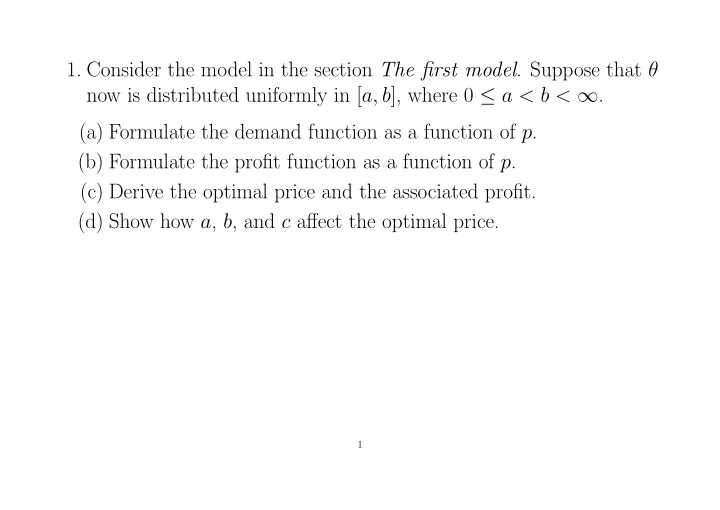

1. Consider the model in the section The first model . Suppose that θ now is distributed uniformly in [ a, b ], where 0 ≤ a < b < ∞ . (a) Formulate the demand function as a function of p . (b) Formulate the profit function as a function of p . (c) Derive the optimal price and the associated profit. (d) Show how a , b , and c affect the optimal price. 1
2. Consider the model in the section Exogenous product quality . Sup- pose that θ now is distributed uniformly in [ a, b ], where 0 ≤ a < b < ∞ . (a) Formulate the demand function as a function of p . (b) Formulate the profit function as a function of p . (c) Derive the optimal price and the associated profit. (d) Show how a , b , c , and q affect the optimal price. 2
3. Consider the model in the section Exogenous product quality . Sup- pose that θ now follows a continuous distribution characterized by the PDF f and CDF F . (a) Formulate the demand function as a function of p . (b) Formulate the profit function as a function of p . (c) Derive an optimality condition for an optimal price. (d) Prove that the optimal price increases in c and q or give a condi- tion under which this is true. 3
4. Consider the binary model in the section Endogenous product qual- ity . Suppose that the product is an information good. While there is no unit production cost, there is an R&D cost cq 2 2 to reach the product quality level q . (a) Formulate the two optimization problems for selling to all con- sumers or only the high-end consumers. (b) Solve the two optimization problems. (c) Give a condition under which serving all customers is better than serving only the high segment. 4
5. Consider the model in the section Exogenous product quality . Sup- pose that now the product is a network good, and a consumer’s utility function of buying the product now becomes θq − p + tx, where x is the number of consumers buying the product and t is the degree of network externality. Assume that θ ∼ Uni(0 , 1). (a) Formulate the demand function as a function of p . (b) Formulate the profit function as a function of p . (c) Derive the optimal price, if possible, or derive an optimality con- dition for an optimal price. (d) Show how c , q , and t affect the optimal price. 5
Recommend
More recommend